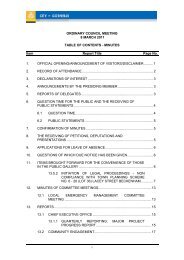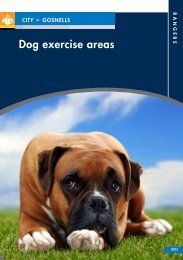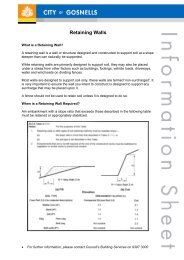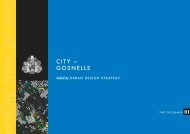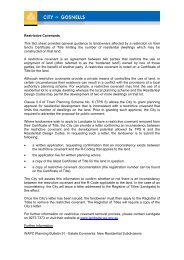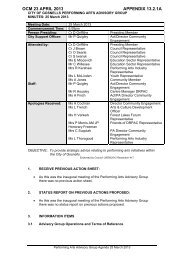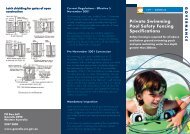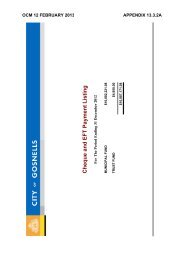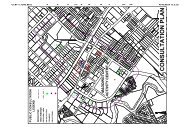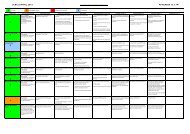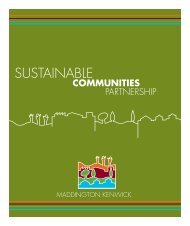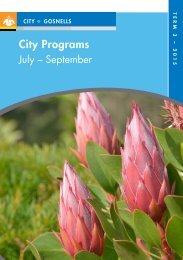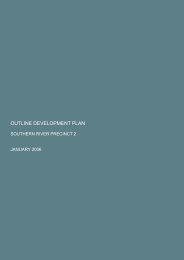Summary - City of Gosnells
Summary - City of Gosnells
Summary - City of Gosnells
You also want an ePaper? Increase the reach of your titles
YUMPU automatically turns print PDFs into web optimized ePapers that Google loves.
Vegetation 56In several blocks in Precinct 2 <strong>of</strong> the MKSEA, this vegetation was in good to degraded condition andincluded floristic components that were not present in the Precinct 1 bushland referred to above, such as theperennial herb Borya scirpoidea (that was abundant in the ground layer) and the shrub Baeckeacamphorosmae. This vegetation appeared to have been lightly grazed and had a mid-dense cover <strong>of</strong>*Ehrharta calycina in some parts. The Corymbia calophylla woodland here graded into two very unusualvegetation types viz. Eucalyptus decipiens mallee (Vegetation Unit M1) and an unusual, species-rich heath(Vegetation Unit SL1) that included floristic elements characteristic <strong>of</strong> the muddy soil <strong>of</strong> Vegetation Unit T1understorey (such as Hakea ceratophylla) but also Conospermum undulatum (which is usually characteristic<strong>of</strong> deep sand habitats).Associates <strong>of</strong> this vegetation included: Acacia willdenowiana, Astartea scoparia, Baeckea camphorosmae,Banksia dallanneyi var. dallanneyi, Banksia littoralis, Borya scirpoidea, Bossiaea eriocarpa,*Briza maxima,Calothamnus rupestris, Conostylis setigera subsp. setigera, Dampiera linearis, Dasypogon bromeliifolius,Desmocladus fasciculatus, Drosera glanduligera, *Ehrharta calycina, Gahnia trifida, Haemodorum laxum,Hakea ceratophylla, Hakea sulcata, Hakea varia, Hypocalymma angustifolium Mud Habitat Variant(C.Tauss 1850), Hypolaena exsulca, Juncus pallidus, Kingia australis, Lepidosperma pubisquameum sens.lat., Lepyrodia curvescens, Lomandra hermaphrodita, Lyginia imberbis, U*Melinis repens, Neurachnealopecuroidea, Nuytsia floribunda,*Olea europaea, Opercularia vaginata, *Orobanche minor, *Paspalumdilatatum, Patersonia occidentalis var. occidentalis, Pericalymma ellipticum var. floridum, Philothecaspicata,*Romulea rosea var. australis, Schoenus pedicellatus, Schoenus rigens, *Sparaxis bulbifera,Tricoryne elatior, Ursinia anthemoides, Verticordia densiflora subsp. densiflora and Viminaria juncea.Vegetation Unit T2: Corymbia calophylla low open forest over open Xanthorrhoea preissii and openAnarthria laevis - Cytogonidium leptocarpoides rushes and sedges.This unit was partly in good condition and inhabited a muddy sand palusplain to gentle slope between about16m and 18m AHD in Precinct 1 <strong>of</strong> the MKSEA. It was very similar to Vegetation Type T1 in floristiccomposition except for the dominance <strong>of</strong> the two rushes Anarthria laevis - Cytogonidium leptocarpoides inthe understorey. Anarthria laevis and Cytogonidium leptocarpoides are both wetland species and are veryuncommon on the SCP. There are no other documented occurrences <strong>of</strong> these species on the SCP inassociation with Corymbia calophylla. Vegetation Unit T2 probably represents vegetation closely related toT1 that was more prevalent in the past on the eastern side <strong>of</strong> the SCP, but has now been cleared. The largeCorymbia calophylla trees in this vegetation are important native fauna habitat (for native birds, bats andpossums); they provide connectivity <strong>of</strong> habitat between the forest <strong>of</strong> the Darling Range and the woodlands <strong>of</strong>the SCP and they also have high landscape value. The thick understorey in part <strong>of</strong> this unit is also habitat forQuenda and other fauna.Associates <strong>of</strong> this vegetation included: Acacia willdenowiana, Banksia dallanneyi var. dallanneyi,,Burchardia umbellata, Calothamnus rupestris, Dasypogon bromeliifolius, *Ehrharta calycina, Hakea varia,Hypocalymma angustifolium Mud Habitat Variant (C.Tauss 1850), Jacksonia furcellata, Kingia australis,Lepidosperma pubisquameum sens. lat., *Leptospermum laevigatum, Lyginia imberbis, * Melinis repens,Mesomelaena tetragona, *Paspalum dilatatum, *Pericalymma ellipticum, Philotheca spicata, Schoenusrigens, Tremulina tremula, Verticordia densiflora var. densiflora, Verticordia lindleyi subsp. lindleyi andWatsonia sp.Vegetation Unit T3: Corymbia calophylla low woodland to low open forest over largely alien understorey.This unit was mostly in a completely degraded condition and inhabited palusplain between about 10 m and12 m AHD in Precincts 1 and 3A. It occurred mainly along the road verges, where it had an understorey <strong>of</strong>alien species, in some places with occasional Xanthorrhoea preissii and Kingia australis shrubs, the nativesedges Baumea juncea and Mesomelaena tetragona and few other natives. There were several large groves<strong>of</strong> fine, mature Corymbia calophylla trees in these areas (larger than any <strong>of</strong> the Corymbia calophylla trees inBFS 387) that had an understorey dominated by the naturalised alien grasses *Eragrostis curvula and*Ehrharta calycina. Several groves <strong>of</strong> smaller Corymbia calophylla that had regrown after clearing werealso present in the MKSEA. The large Corymbia calophylla trees in this vegetation are important nativefauna habitat (for native birds, bats and possums); they provide connectivity <strong>of</strong> habitat between the forest <strong>of</strong>the Darling Range and the woodlands <strong>of</strong> the SCP and they also have high landscape value.Tauss, C. and Weston, A.S. (2010). The flora, vegetation and wetlands <strong>of</strong> the Maddington-Kenwick Strategic Employment Area.A survey <strong>of</strong> the rural lands in the vicinity <strong>of</strong> the Greater Brixton Street Wetlands. Report to the <strong>City</strong> <strong>of</strong> <strong>Gosnells</strong>, W.A. Version 18.04.10



